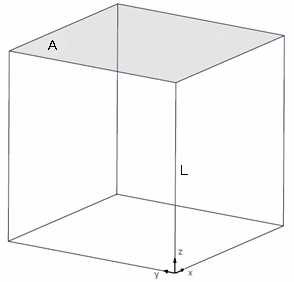Self-balancing is usually combined with iso-static restraint. This option automatically adds inertia forces in order to counter balance external loads. Thus the global loading equals null.
Reference:
3D model parabolic hexahedron elements (HE20), computed with CATIA.
 Specifications
Specifications
Geometry Specifications
|
L = 0.1 m |
|
Analysis Specifications
| Young Modulus (material):
E = 200 GPa |
 |
| Poisson's Ratio (material): ν = 0.3 |
|
Mesh Specifications:
|
|
| Restraints: Iso-static restraint |
|
Loads:
|
 Results
Results
Analytical Solution
In uniaxial traction along Z, on
surface A:
![]() zz=
Fz/SA =
100/(0.1 x 0.1) = 100 N/m2
zz=
Fz/SA =
100/(0.1 x 0.1) = 100 N/m2
Reactions to forces which counter balance external loads must be null.
Computed Results
|
Value |
Reference |
Parabolic hexahedron HE20 |
Normalized results |
|
|
100 |
100 |
1 |
Reactions to displacement restraints are null.
To Perform the Test:
The self_balancing.CATAnalysis document presents a complete analysis, computed with a mesh formed of parabolic hexahedron elements (HE20).
To compute the case, proceed as follow:
-
Open the CATAnalysis document.
-
Compute the case in the Generative Structural Analysis workbench.
